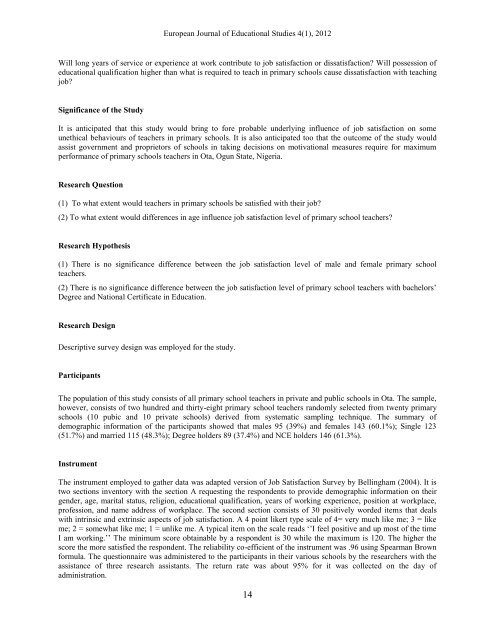Volume 4 Issue 1 (February 2012) - Ozean Publications
Volume 4 Issue 1 (February 2012) - Ozean Publications
Volume 4 Issue 1 (February 2012) - Ozean Publications
Create successful ePaper yourself
Turn your PDF publications into a flip-book with our unique Google optimized e-Paper software.
European Journal of Educational Studies 4(1), <strong>2012</strong><br />
Will long years of service or experience at work contribute to job satisfaction or dissatisfaction Will possession of<br />
educational qualification higher than what is required to teach in primary schools cause dissatisfaction with teaching<br />
job<br />
Significance of the Study<br />
It is anticipated that this study would bring to fore probable underlying influence of job satisfaction on some<br />
unethical behaviours of teachers in primary schools. It is also anticipated too that the outcome of the study would<br />
assist government and proprietors of schools in taking decisions on motivational measures require for maximum<br />
performance of primary schools teachers in Ota, Ogun State, Nigeria.<br />
Research Question<br />
(1) To what extent would teachers in primary schools be satisfied with their job<br />
(2) To what extent would differences in age influence job satisfaction level of primary school teachers<br />
Research Hypothesis<br />
(1) There is no significance difference between the job satisfaction level of male and female primary school<br />
teachers.<br />
(2) There is no significance difference between the job satisfaction level of primary school teachers with bachelors‟<br />
Degree and National Certificate in Education.<br />
Research Design<br />
Descriptive survey design was employed for the study.<br />
Participants<br />
The population of this study consists of all primary school teachers in private and public schools in Ota. The sample,<br />
however, consists of two hundred and thirty-eight primary school teachers randomly selected from twenty primary<br />
schools (10 pubic and 10 private schools) derived from systematic sampling technique. The summary of<br />
demographic information of the participants showed that males 95 (39%) and females 143 (60.1%); Single 123<br />
(51.7%) and married 115 (48.3%); Degree holders 89 (37.4%) and NCE holders 146 (61.3%).<br />
Instrument<br />
The instrument employed to gather data was adapted version of Job Satisfaction Survey by Bellingham (2004). It is<br />
two sections inventory with the section A requesting the respondents to provide demographic information on their<br />
gender, age, marital status, religion, educational qualification, years of working experience, position at workplace,<br />
profession, and name address of workplace. The second section consists of 30 positively worded items that deals<br />
with intrinsic and extrinsic aspects of job satisfaction. A 4 point likert type scale of 4= very much like me; 3 = like<br />
me; 2 = somewhat like me; 1 = unlike me. A typical item on the scale reads „‟I feel positive and up most of the time<br />
I am working.‟‟ The minimum score obtainable by a respondent is 30 while the maximum is 120. The higher the<br />
score the more satisfied the respondent. The reliability co-efficient of the instrument was .96 using Spearman Brown<br />
formula. The questionnaire was administered to the participants in their various schools by the researchers with the<br />
assistance of three research assistants. The return rate was about 95% for it was collected on the day of<br />
administration.<br />
14

















